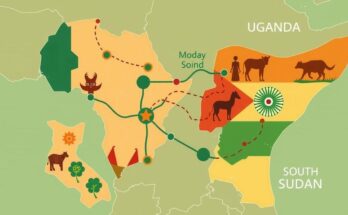The Islamic State West Africa Province (ISWAP) has escalated its insurgency tactics in the Lake Chad Basin, notably employing armed drones for the first time in direct combat. This shift poses significant challenges for counter-terrorism efforts, highlighting the urgent need for advanced counter-drone technology and a coordinated regional response. Moreover, ISWAP’s increased capabilities, supported by external networks, underscore a troubling evolution in warfare that regional governments must address promptly.
The recent insurgent activities in the Lake Chad Basin demonstrate a significant escalation in the tactics employed by the Islamic State West Africa Province (ISWAP). Notably, the 24 December 2024 attack on Nigeria’s Forward Operating Base in Wajiroko marked the first confirmed instance of a terrorist group in this region utilizing armed drones in combat, leading to the injury of several soldiers. This development indicates a profound shift in the nature of counter-terrorism challenges present in the area.
ISWAP’s recent operations, involving drone attacks, signal a dangerous evolution in their insurgency. While state armed forces have long employed drone technology, the Institute for Security Studies (ISS) warned as early as 2023 that ISWAP was progressing rapidly towards utilizing drones for offensive purposes. This strategic shift was underscored during the Lake Chad Basin Governors’ Forum, emphasizing an urgent need for adaptive security measures to effectively combat this evolving threat.
Initially, ISWAP employed drones for propaganda and reconnaissance, mimicking similar tactics used by extremist groups in places like Somalia and Libya. However, as they weaponize these technologies, non-state actors have enhanced their operational capabilities, posing new challenges for regional security forces. Moreover, recent videos released by ISWAP illustrate their advanced recruitment and training programs, including the use of sophisticated weaponry.
The presence of foreign trainers supporting ISWAP’s operational enhancements has become increasingly evident. Recent testimonies from ex-ISWAP fighters suggest the group’s proficiency with advanced weapons and technology is bolstered through external support. The organization’s specialized training programs are producing combatants skilled in various roles, contributing to ISWAP’s resilience and strategic planning for sustained insurgency efforts.
Despite ongoing operations by national forces and the Multinational Joint Task Force (MNJTF), the evolving nature of ISWAP’s tactics requires intensified focus and resources. Major General Godwin Mutkut, during the Maiduguri forum, highlighted the absence of counter-drone technologies, a critical gap that leaves security personnel exposed to aerial threats.
Three pressing questions arise: the source of ISWAP’s drone technology, the networks facilitating this acquisition, and the necessary measures regional forces must undertake to counter this new warfare strategy. Research indicates ISWAP’s successful drone program is underpinned by smuggling routes and arms trafficking, reflecting a sophisticated operational structure capable of executing high-impact assaults.
The potential for ISWAP to carry out significant attacks while minimizing casualties is alarming. The group’s use of drones may exacerbate psychological warfare, creating a climate of fear in affected communities. This could undermine civilian trust in governmental protection, inadvertently increasing local support for insurgency.
To effectively counter ISWAP’s rising threat, regional governments must prioritize the deployment of counter-drone measures. This includes enhancing intelligence sharing among Nigeria, Chad, Niger, and Cameroon to disrupt ISWAP’s logistical networks. Strategies such as enhanced checkpoint searches and preemptive strikes on drone facilities must be implemented as a high priority.
Moreover, addressing the socio-economic vulnerabilities that fuel ISWAP’s recruitment is also essential. Improving governance, security, and economic opportunities in rural regions can mitigate the conditions conducive to extremism. Collaborative efforts with international partners for technical expertise and intelligence support will be vital in confronting ISWAP’s evolving tactics and ensuring long-term stability in the Lake Chad Basin region.
The emergence of armed drones in the Lake Chad Basin represents a critical juncture in the counter-terrorism landscape, necessitating a reevaluation of current strategies. The escalation of tactics by ISWAP, marked by the use of sophisticated technology and the recruitment of specialized fighters, poses significant challenges to regional security forces. A thorough and coordinated response is imperative, combining immediate tactical enhancements with long-term efforts to address underlying socio-economic issues.
Original Source: allafrica.com




